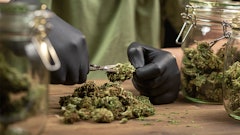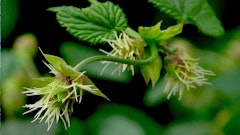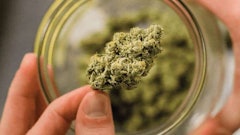8 Tips to Freeze-Dry Cannabis Flower
Welcome to this season’s finale of “Tricks of the Trade”!

The Cannabis Business Times team is concluding this four-part video series with “How to Freeze-Dry Cannabis Flower,” a bit of a novel process that uses liquid nitrogen in a cryogenic technique that includes speed and control for a fresh-frozen flower that is preserved—terpenes, cannabinoids and all—immediately after harvest. It’s very much a live-plant process.
Also included in this “how-to” demonstration track, which spotlights the day-to-day operations of cannabis industry professions, we’ve featured “How to Infuse Chocolate,” “How to Fill Vape Carts,” and “How to Defoliate a Canopy.” Those episodes can be viewed on our website or our YouTube page.

In this closing installment of season one, we’re back at Buckeye Relief, a Northeast Ohio cultivator and processor that hang dries roughly 900 pounds of flower every three weeks. Post-Harvest Director Nathan Ferencak and the company’s former freeze-drying technician, Neil Kopchak, take us behind the scenes to show us their freeze-drying process, which the Buckeye Relief team first dialed in with 2- to 4-pound batches every few weeks in early 2022.
“We didn’t want to dive headfirst into it,” Ferencak says about starting with craft quantities before possibly investing hundreds of thousands of dollars into a commercial freeze-dryer. “We wanted to make sure it was the right method for our facility.”
While freeze-dried flower is a significantly faster process than hang-dried flower, both are followed by a minimum cure of 30 days to bring out the unique aroma and taste of each strain. And while drying is just one element of the post-harvest process, it holds major implications for the final quality of flower products.
Here, Ferencak and Kopchak share 8 tips from their freeze-drying process:
1. Experiment: Start small and develop a process that works for your post-harvest team before making a major investment.
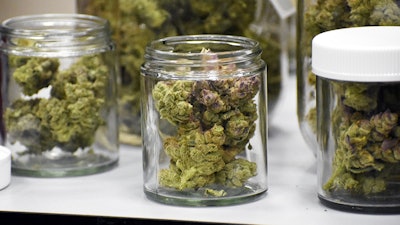
A state-of-the-art commercial freeze-drying unit could cost upward of $500,000 to $1 million in order to incorporate the innovative drying method at scale for larger cannabis operators, Ferencak says.
Before even entertaining that type of investment, the team at Buckeye Relief wanted to make sure freeze-dried flower was a good fit within its post-harvest workflow as well as if it made sense as a product for patients in Ohio’s medical market.
In late 2020, Kopchak, a Cleveland School of Cannabis graduate, helped build an in-house freeze-dryer for experimentation before the Buckeye Relief team dove into its small-craft production, Ferencak says. After some trial and error, Buckeye Relief purchased a $500 freezer-dryer from the 1990s that was used for food preparations—and repurposed it for cannabis flower.
“Beginning of 2022, we really started to try and delve more into it and try to figure out what the best techniques are and how to get the best products out,” he says. “It’s about a two-year process to get to where we’re at now, and still, we’re not producing as much as we would like at scale.”
2. Curing: Time out your facility’s workflow before the freeze-drying process.
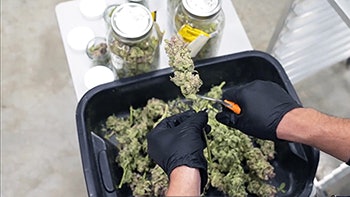
The drying phase of freeze-dried flower takes roughly 24 to 48 hours compared to whole-plant hang-dried flower, which usually takes seven to 10 days in Buckeye Relief’s post-harvest process.
That means the trimming, curing and packaging cycles could come a week or more earlier for freeze-dried flower from the same harvest. But once the calendar is adjusted for that quicker dry time, the curing process doesn’t differ too much for freeze-dried flower, Ferencak says.
“The curing process is basically the same,” he says. “We’re checking on it every few days, making sure we’re burping it, checking for moisture content. … The moisture content between dry hang and the freeze-dryer, we want basically relatively the same. So, the curing process is not too much interrupted by it.”
Operating in different regions or climates, drying and curing cannabis can become somewhat of an art: Too much moisture allows mold or different microbial growth, while not enough moisture can diminish the terpene and cannabinoid profiles.
Learn more about the art of drying and curing from CBT columnist Kenneth Morrow here, or the science behind it from Cannabis Conference 2022 speaker Dr. Allison Justice here.
3. Act Quickly: The fresher the cannabis, the better in the freeze-drying process.
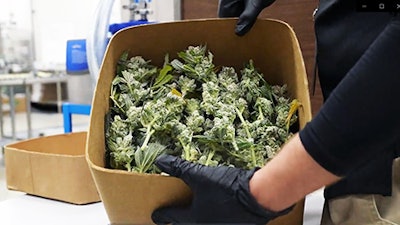
Once the harvest team chops down the cannabis plants from one of Buckeye Relief’s flower rooms, the freeze-drying team wants to freeze that cannabis as soon as possible, Kopchak says.
If there are 50 tables with roughly a dozen plants each from a harvest, just one of those tables is reserved for Buckeye Relief’s freeze-drying team while the rest are kept for traditional hang drying.
“We cut down the cannabis plant, we bring it in here, and I just start bucking the buds off—start bucking the branches to the size that I want,” Kopchak says. “And then, right after that, I put it in cardboard barrels or bins, and then I hit it with liquid nitrogen. After that, I put it in the freeze-dryer and then it’s good for storage. … The quicker you can get your process done, the better the run is going to come out.”
4. Preparations: Ensure proper spacing of buds in the drying chamber.
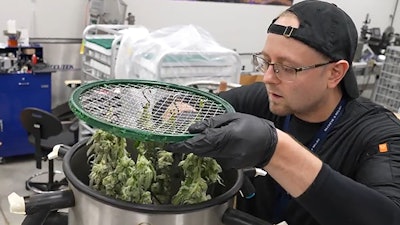
After Kopchak bucks the cannabis branches to a length that will fit in the drying chamber he uses for the liquid nitrogen process, he hangs eight to 10 of the branches with hooks on circular tray that fits in the chamber.
From there, he lowers the tray into the drying chamber and makes sure the buds from different colas have proper spacing.
“I’m watching out and making sure no buds get hooked on anything,” Kopchak says. “Just setting it in here making sure they’re not touching the bottom of the chamber, making sure everything’s hanging real nice, nothing’s in front of one another just so all the air can move.”
5. Temperature and Safety: Prime your liquid nitrogen tank.
After the flower is situated in the drying chamber, Kopchak primes the liquid nitrogen tank to ensure the liquified element is coming out cold and steady from the hose he uses for the drip.
In addition, Kopchak puts on his safety gloves before handling. Liquid nitrogen has a boiling point of roughly -196 degrees Celsius (-320 degrees Fahrenheit) at atmospheric pressure. Direct contact can freeze the skin, causing frostbite and cold burns.
6. Slow and Controlled: Don’t blast off your trichomes.
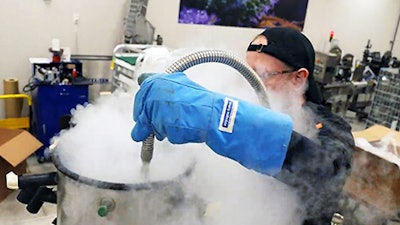
The whole idea behind freeze-dried cannabis flower is to preserve the terpenes and cannabinoids in a live-plant process.
When Kopchak finally starts adding the liquid nitrogen drip to the drying chamber with the flower branches, he makes sure the pressure isn’t too high to the point where he could be disrupting the integrity of the product.
“I want it to be a slow drip,” he says. “I don’t want it to be a fast drip. I’m not trying to blow all the trichomes off. So, this is when I start throttling [the liquid nitrogen tank] and I just check it out. … You want to watch what you’re doing with the liquid nitrogen because the trichomes become like glass then—they’ll just fall right off.”
7. Consistency: Don’t overdo it with the liquid nitrogen.
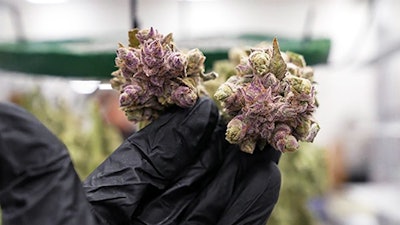
The drip phase is very much an eyeball-and-go process, where Kopchak keeps a constant visual on the flower to make sure the drip is hitting all the branches and bud sites for uniform freezing throughout but without overdoing it.
“I do it until all the weed is frozen,” he says. “So, everything has a real good freeze on it. That’s how I get the color to pop. That’s how I get everything to come out real nice. That’s how I get the smell to stay. You want everything to stay frozen. And then there’s no possible way of microbials growing.”
In this specific video demonstration, Kopchak lets the liquid nitrogen drip into the drying chamber for roughly 60 seconds.
“You don’t want to overpack it,” he says. “If you overpack it, you’re going to suck all of the water right into the vacuum pump. That’s why I have a secondary cold trap on the back that I placed on there.”
8. Cap and Dry: Let the machine do its work.
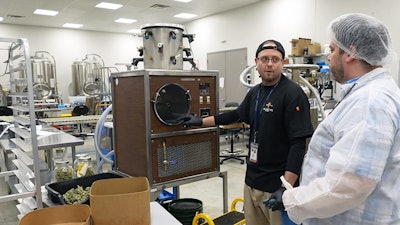
After he finishes the liquid nitrogen drip, Kopchak puts a lid on the drying chamber and flips the switches to turn on Buckeye Relief’s freeze-dryer.
While a lot of what the Buckeye Relief team does is in this video is unique—in regard to using a repurposed fruits and vegetables freeze-dryer from the 1990s—the general concept of the process is more ubiquitous once the machine is running.
“What’s happening is that weed is all wet,” Kopchak says. “And it’s not evaporating. It’s going through sublimation, and this is my cold trap. So, this is where all the water that’s inside the [flower] is going to be trapped inside here. It’s going to turn into ice. … [The flower] gets [dried] in about 24 to 48 hours, depending on how much you pack it.”
That timeframe is somewhat touchy, he says.
“That’s one of the tricks, is trying to get the same amount of moisture as in a hang dry,” Kopchak says. “In this [freeze-dryer], you could overcook it real easy.”
After it’s properly freeze-dried, the cannabis can be trimmed, cured and packaged.
















